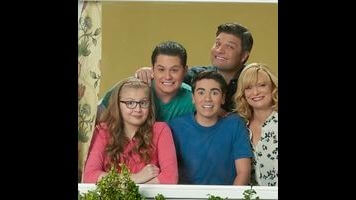But even if they could summon the courage to debase themselves with all 22 minutes of the Real O’Neals’ first episode, the MRCs and FRCs of the world would find it’s Savage’s show in executive producer credit only. They’d find no knee-jerk digs at organized religion or right-wing politicians being equated with the foamy leftovers of anal sex. Instead, they’d see the members of an Irish-Catholic family from Chicago dealing with truths they’ve kept from one another for years: Mom and dad (Martha Plimpton and Jay R. Ferguson) are splitting up; oldest son Jimmy (Matt Shively) is anorexic; little sister Shannon (Bebe Wood) is a burgeoning criminal mastermind. Middle child and series narrator Kenny (Noah Galvin), meanwhile, is gay, one of the series’ last connections to its semi-autobiographical roots—along with the occasional sight of Ferguson in a Chicago Police Department uniform.
On its way to air, The Real O’Neals has picked up many people’s fingerprints, and its roster of producers comprises seemingly everyone with a) an overall deal with ABC Studios, b) experience with family sitcoms, and c) downtime from running their own shows. This doesn’t result exactly in a too-many-cooks scenario, but it does bear the distinct markings of ABC’s post-Modern Family house style: Voiceover narration setting the scenes and tidily summarizing the plots, a bumbling dad whose primary trait is being a bumbling dad, a precociously menacing youngest sibling. The O’Neals’ dirty laundry—conveniently aired at a congregation charity drive—makes them pariahs of the parish. But nobody would say “There goes the neighborhood” if they moved in next door to the Hecks, the Goldbergs, the Johnsons, or the Huangs—the last of whom will share a Tuesday-night cul de sac with The Real O’Neals (but not Fresh Off The Boat’s strong sense of identity or assured comedic voice).
Much is made in the pilot about the family’s confidential information suddenly going public, but the new normals that actually matter to the series are Kenny’s sexuality and Eileen and Pat’s separation. That’s for the best. The Real O’Neal has some jagged edges, but its overall tone isn’t dark enough to wring any humor out of teenage eating disorders; Shannon’s Keyser Söze act lands more cleanly when she can show her Verbal Kint side. Really, there are enough potential stories in Plimpton’s and Galvin’s characters to make each the center of their own show: One about a woman starting all over (and sometimes actively fighting that restart) in the middle of her life, the other about a young man just starting to live his. In the four episodes of The Real O’Neals screened for critics, those two premises are shoehorned into a single show, which derives plenty of readymade conflict from a keeping-up-appearances Catholic and her openly gay son.
Galvin and Plimpton quickly establish themselves as the halves of the show’s central relationship, and their scenes together give The Real O’Neals both its most relatable family moments and its most outlandish sitcom beats. As Eileen’s front-page-of-the-church-bulletin life comes crashing down around her, Plimpton ably conveys a balance of maternal warmth and religious panic. Eileen’s fervor taps in to the wild-eyed energy that stole so many scenes for Plimpton on Fox’s underrated Raising Hope; unfortunately, it’s also what leads the character to conspire with her son’s former beard to screw the gay out of Kenny. Still, the show pops whenever Plimpton or newcomer Galvin is on the screen, sometimes in a literal, visual burst: Recurring fantasy sequences give The Real O’Neals a live-action-cartoon vibe reminiscent of Malcolm In The Middle, Scrubs, Don’t Trust The B—— In Apartment 23, or The Neighbors—all previous work experience for the folks writing and producing the O’Neals.
But that daydreaming streak—like the second-episode runner that visits mounting physical harm on Kenny’s ex, or the show’s reliance on hiding punchlines behind bleeped speech and blurred mouths—is a façade. Outside of Kenny and Eileen’s personal journeys, the stuff of The Real O’Neals trends toward the conventional: Jimmy frets about Pat moving out of the house, Pat and Eileen squabble over furniture purchases, Pat takes Shannon shopping for tampons. (Ferguson is his reliably charming self throughout, but the erstwhile Stan Rizzo deserves better than Pat O’Neal.) Not to mention that coming-out narratives have become their own sort of conventional, something a different ABC sitcom managed to sidestep and put to touching use earlier this broadcast season. Conservative watchdogs needn’t have feared The Real O’Neals, and Eileen doesn’t have to pray for the fictional ones, either. The wish she makes multiple times has already come true: By ABC standards, as well as modern conventions, the O’Neals couldn’t be more normal. It’s just too bad that they’re not as distinct as their show thinks they are. Eileen may want to blend in more, but The Real O’Neals needs to stand out.


 Keep scrolling for more great stories from A.V. Club.
Keep scrolling for more great stories from A.V. Club.